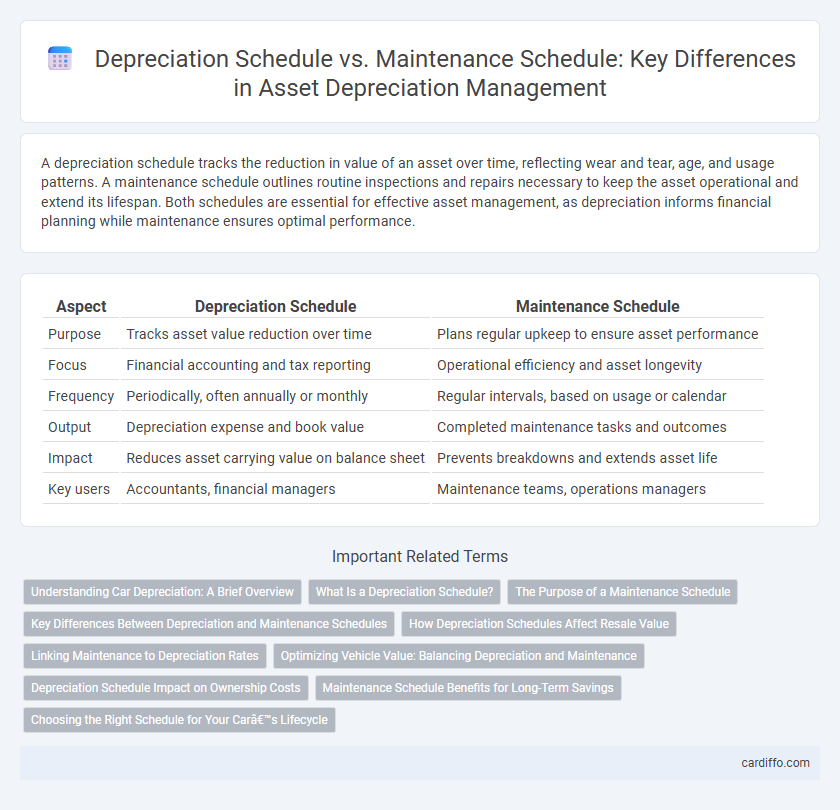A depreciation schedule tracks the reduction in value of an asset over time, reflecting wear and tear, age, and usage patterns. A maintenance schedule outlines routine inspections and repairs necessary to keep the asset operational and extend its lifespan. Both schedules are essential for effective asset management, as depreciation informs financial planning while maintenance ensures optimal performance.
Table of Comparison
| Aspect | Depreciation Schedule | Maintenance Schedule |
|---|---|---|
| Purpose | Tracks asset value reduction over time | Plans regular upkeep to ensure asset performance |
| Focus | Financial accounting and tax reporting | Operational efficiency and asset longevity |
| Frequency | Periodically, often annually or monthly | Regular intervals, based on usage or calendar |
| Output | Depreciation expense and book value | Completed maintenance tasks and outcomes |
| Impact | Reduces asset carrying value on balance sheet | Prevents breakdowns and extends asset life |
| Key users | Accountants, financial managers | Maintenance teams, operations managers |
Understanding Car Depreciation: A Brief Overview
A depreciation schedule outlines the reduction in a car's value over time due to factors such as age, mileage, and wear, providing a financial timeline for asset value loss. In contrast, a maintenance schedule details routine service activities required to keep the vehicle operating efficiently and minimize unexpected repair costs. Understanding the relationship between depreciation and maintenance schedules helps car owners optimize resale value while ensuring the vehicle's longevity and performance.
What Is a Depreciation Schedule?
A depreciation schedule is a detailed plan that outlines the allocation of an asset's cost over its useful life, reflecting its declining value for accounting and tax purposes. It tracks the periodic depreciation expense, enabling businesses to manage asset value accurately and comply with financial reporting standards. Unlike a maintenance schedule that focuses on upkeep activities to preserve asset functionality, a depreciation schedule quantifies asset wear and usage over time.
The Purpose of a Maintenance Schedule
A maintenance schedule is designed to ensure the optimal performance, safety, and longevity of assets by outlining regular inspections and servicing intervals. It helps prevent costly breakdowns and extends the useful life of equipment, effectively complementing depreciation schedules that track asset value reduction over time. Unlike depreciation schedules, maintenance schedules focus on proactive care to maintain asset functionality and reliability.
Key Differences Between Depreciation and Maintenance Schedules
A depreciation schedule tracks the reduction in value of assets over time based on usage and age, while a maintenance schedule outlines routine tasks to ensure equipment operates efficiently and prevents breakdowns. Depreciation schedules are primarily financial tools used for accounting and tax purposes, reflecting asset lifespan and residual value, whereas maintenance schedules serve operational goals, focusing on reliability and safety. Understanding these differences helps businesses optimize asset management by balancing cost recovery with proactive upkeep.
How Depreciation Schedules Affect Resale Value
Depreciation schedules systematically allocate the reduction in asset value over time, directly impacting the resale value by accounting for wear, usage, and obsolescence. A precise depreciation schedule enables accurate market valuation forecasts, influencing buyer perception and sale price negotiations. In contrast, maintenance schedules preserve asset condition but do not quantify value loss, making depreciation schedules essential for strategic resale timing and financial planning.
Linking Maintenance to Depreciation Rates
Linking maintenance to depreciation rates enhances asset management by extending useful life and reducing accelerated value loss. A detailed maintenance schedule directly influences depreciation schedules by preserving equipment condition, which slows depreciation and improves financial reporting accuracy. Optimizing maintenance activities lowers repair costs and stabilizes depreciation expenses, resulting in more precise asset valuation.
Optimizing Vehicle Value: Balancing Depreciation and Maintenance
Optimizing vehicle value requires balancing a precise depreciation schedule with a consistent maintenance schedule to minimize asset loss and maximize longevity. Depreciation schedules forecast the decline in vehicle value over time, while maintenance schedules focus on preventing accelerated wear and tear that can deepen depreciation effects. Coordinating both schedules helps sustain market value by ensuring the vehicle operates efficiently and retains its appeal to potential buyers.
Depreciation Schedule Impact on Ownership Costs
A detailed depreciation schedule directly influences ownership costs by forecasting an asset's value decline over time, enabling more precise budgeting for future expenses. This schedule helps owners anticipate financial impacts from asset wear and tear, informing decisions on replacement or repair timing that maintenance schedules alone may not reveal. By integrating depreciation data with maintenance planning, businesses can optimize total lifecycle costs and improve investment returns.
Maintenance Schedule Benefits for Long-Term Savings
A well-planned maintenance schedule minimizes equipment wear and extends asset lifespan, directly reducing the frequency and severity of costly repairs often overlooked in depreciation schedules. Proactive maintenance preserves asset value by preventing accelerated depreciation caused by neglect and operational inefficiencies. Regular upkeep enhances operational efficiency and reliability, leading to substantial long-term savings beyond the accounting scope of depreciation expenses.
Choosing the Right Schedule for Your Car’s Lifecycle
A depreciation schedule estimates the gradual loss of a car's value over time, reflecting wear, age, and market trends, while a maintenance schedule outlines necessary service intervals to optimize performance and prevent costly repairs. Choosing the right schedule involves balancing the car's expected resale value against upkeep costs, ensuring financial planning aligns with the vehicle's lifecycle stage. Prioritizing maintenance can extend lifespan and reduce depreciation rate, but ignoring depreciation trends may lead to underestimated costs.
Depreciation Schedule vs Maintenance Schedule Infographic

 cardiffo.com
cardiffo.com